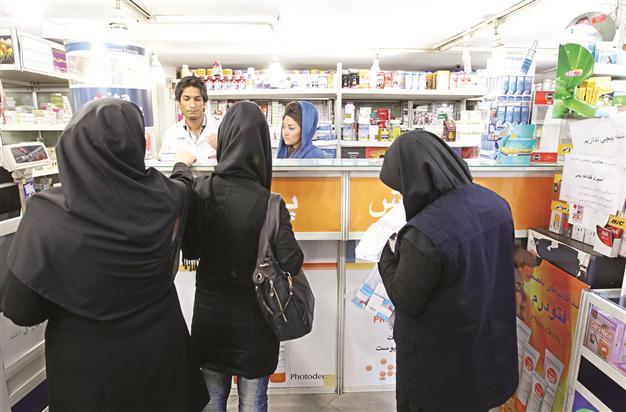Sanctions bite Iran’s health sector
TEHRAN - The Associated Press

Iranian women buy medicine from a pharmacy in Tehran. The prices of some medicines and paramedical equipment have increased by 200 percent. AFP photo
For the first time in more than a decade, the black market pharmaceutical peddlers are back on Nasser Khosrow Street near Tehran’s main bazaar, as Western sanctions over the country’s nuclear program have indirectly limited normal supplies to hospitals and pharmacies.
“Medicine, medicine,” the street dealers shout. “Any kind you want.” For many Iranians, such underground channels are now the only way to get needed, or even life-saving, drugs after the sanctions on the country.
But for others, even the sidewalk touts are not an option. Iran’s sinking currency has more than doubled the prices of some of the imported medicines and supplies, potentially putting them out of reach for lower-income patients. While medicine and humanitarian supplies are not blocked by the economic embargoes on Iran, the pressures are clearly evident in nearly every level of Iranian health care. It’s a sign of the domino effect of sanctions on everyday life.
Restrictions on Iran’s access to international banking networks mean major obstacles to pay for imported medicine and equipment, the same troubles facing many businesses in need of shipments from abroad. Meanwhile, the nation’s slumping currency, seen as collateral damage from sanctions, has driven up prices sharply. An imported wheelchair now costs 10 times more than last fall. A blood-sugar test kit has more than doubled to 540,000 rials, or about $18.
The black market still finds ways to get medical supplies through smuggling routes or by simply carrying shipments by hand, but the prices can be even higher than on regular shelves. “You pay in advance and I will bring the medicine you need later,” said Behzad, a street medicine dealer who would give only his first name. “We have all sorts of medicines: European, Indian or Chinese. It depends on your budget.” Prices for nearly everything, including health services and medicine, continue to climb as the rial stumbles along at about one-third its exchange rate value compared with 18 months ago.
Scenes of overcrowded state hospitals are now common across Iran with fees for private health care having nearly doubled in recent months. The costs in state-run facilities are far cheaper, but that also comes with shortages and long waits.
High prices cause deaths“Sometimes we don’t even have serum for dehydrated patients, said a young doctor, speaking on condition of anonymity because he was worried that comments to the media could jeopardize his job at a state-run hospital. The prices for other items have soared in recent months: radiology film up 240 percent; helium gas for MRIs up 667 percent; filters for kidney dialysis up 325 percent. The cost of one round of chemotherapy for cancer has reached 200 million rials, or $65,000, from 800 million rials, or $25,000, last year.
The independent Hamshari daily quoted a father, who was not named in the article, as saying his child died because he couldn’t afford the higher price of an artificial heart valve.
Hossein Ali Shahriari, head of the Iranian Parliament’s health committee, said he had appealed to President Mahmoud Ahmadinejad to address shortages and rising prices in the health sector. Today, prices of some medicines and paramedical equipment have increased by 200 percent, he said. Shahriari said even powdered milk for infants was not available in some pharmacies.
